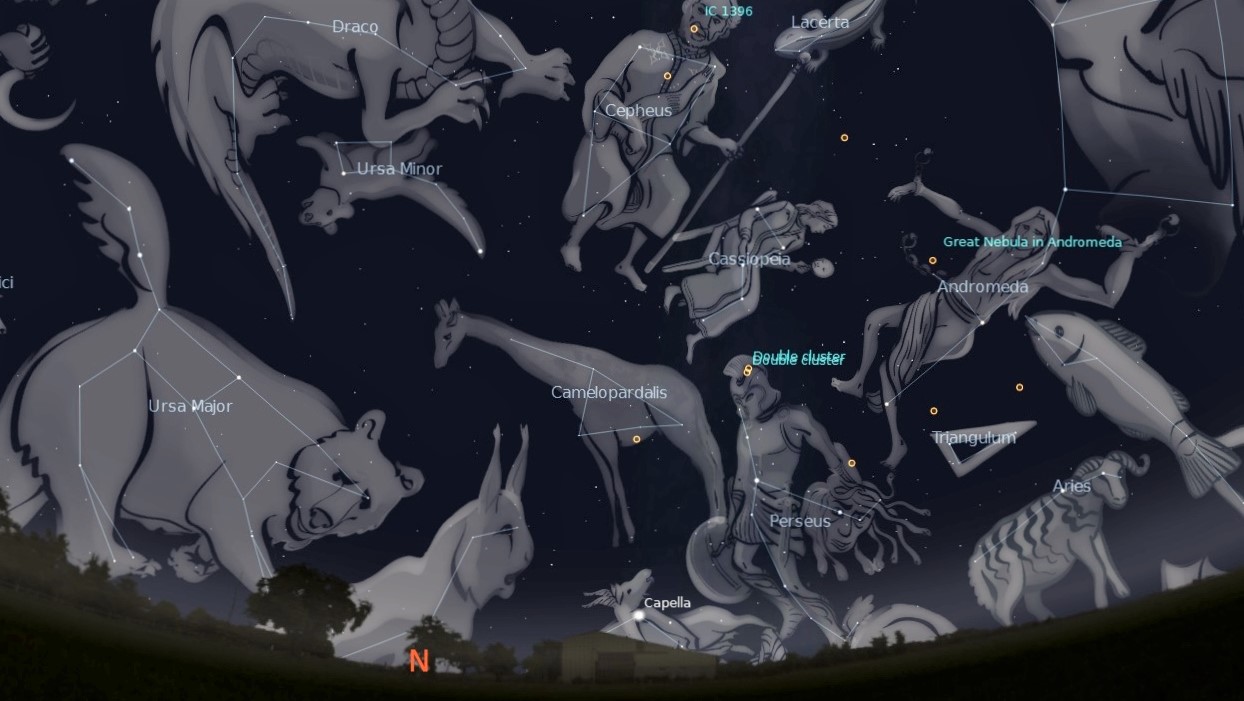This Week’s Sky at a Glance, 2020 August 22 – 29 ~by Curt Nason
The signs of autumn appear in the sky before they become readily apparent terrestrially. As darkness settles the great mama bear, Ursa Major, scampers across the northern horizon in search of food and lodging for winter. If you live in a rural area with an excellent view to the north you might even catch a glimpse of Lynx running ahead of the bear, and consider yourself fortunate if you do. The thicker layer of atmosphere at low altitudes reduces the brightness of starlight, a phenomenon called extinction. The lynx may become extinct for a few hours.
The bowl of the Little Dipper (Ursa Minor) is upside down in early evening, pouring out its contents to fill the Big Dipper below, at the rear of Ursa Major. This scenario is at odds with Greek mythology, for the bears were cursed to eternal thirst by the goddess Hera in revenge for an indiscretion of her husband, Zeus. She placed the bears in a position where they never reach the horizon for a drink. Perhaps Zeus placed dippers of water inside the bears so that they could share water and survive. Someone has to make these stories up.
To the east Pegasus is already quite high after twilight, with its signature square asterism tilted as a diamond for the imminent baseball pennant stretch. Perseus stands above the northeast horizon below his in-laws, W-shaped Cassiopeia and house-shaped Cepheus, while their daughter Andromeda leads him toward the flying horse. There is much to see in this area with binoculars but start with the Double Cluster of stars between Perseus and Cassiopeia, and the Andromeda Galaxy (M31).
This autumn preview is not a fleeting glimpse. The eastward progression of constellations from evening to evening is compensated by earlier sunsets, such that they emerge from twilight in the same part of the sky for many weeks. Autumn is a great time for stargazing.
This Week in the Solar System
Saturday’s sunrise in Moncton is at 6:27 am and sunset will occur at 8:15 pm, giving 13 hours, 48 minutes of daylight (6:34 am and 8:18 pm in Saint John). Next Saturday the Sun will rise at 6:36 am and set at 8:02 pm, giving 13 hours, 26 minutes of daylight (6:42 am and 8:06 pm in Saint John).
The Moon is at first quarter on Tuesday. See if you can spot the Lunar X with a telescope that evening, within the shadow line below centre, starting an hour before sunset. Jupiter and Saturn are at their best for observing between 10 pm and 11 pm, at their highest in the south. Telescope users can catch three of Jupiter’s moons emerging from the planet’s shadow this week: Io on Monday at 8:58 pm, Ganymede on Tuesday at 8:59 pm, and Europa on Wednesday at 11:54 pm. By midnight Mars will be high enough to show its south polar ice cap through a telescope. Venus dominates the morning sky, and we will have to wait a few weeks to see Mercury in the evening sky.
With astronomy meetings and outreach activities on hold, you can watch the local Sunday Night Astronomy Show at 8 pm and view archived shows.
Questions? Contact Curt Nason.

